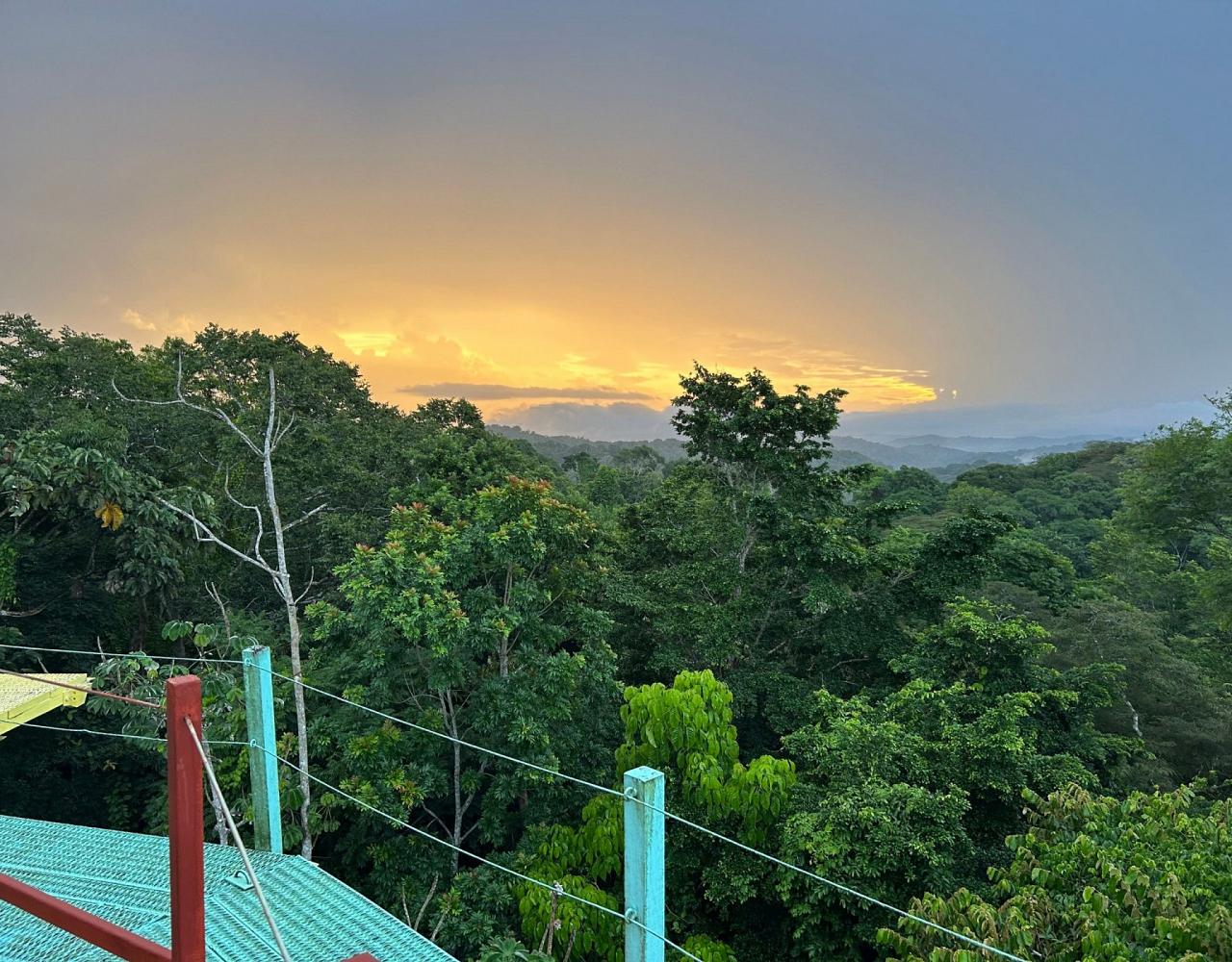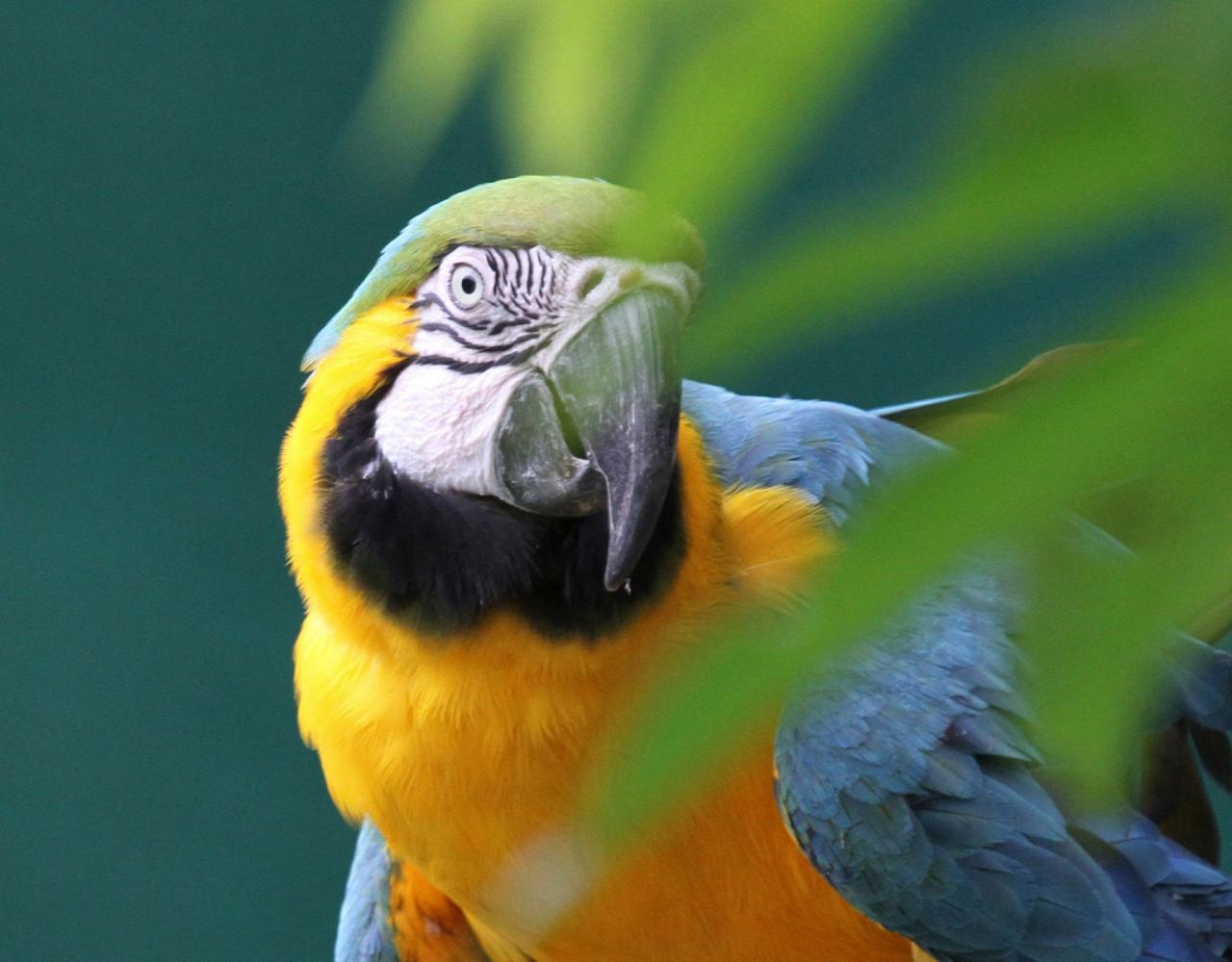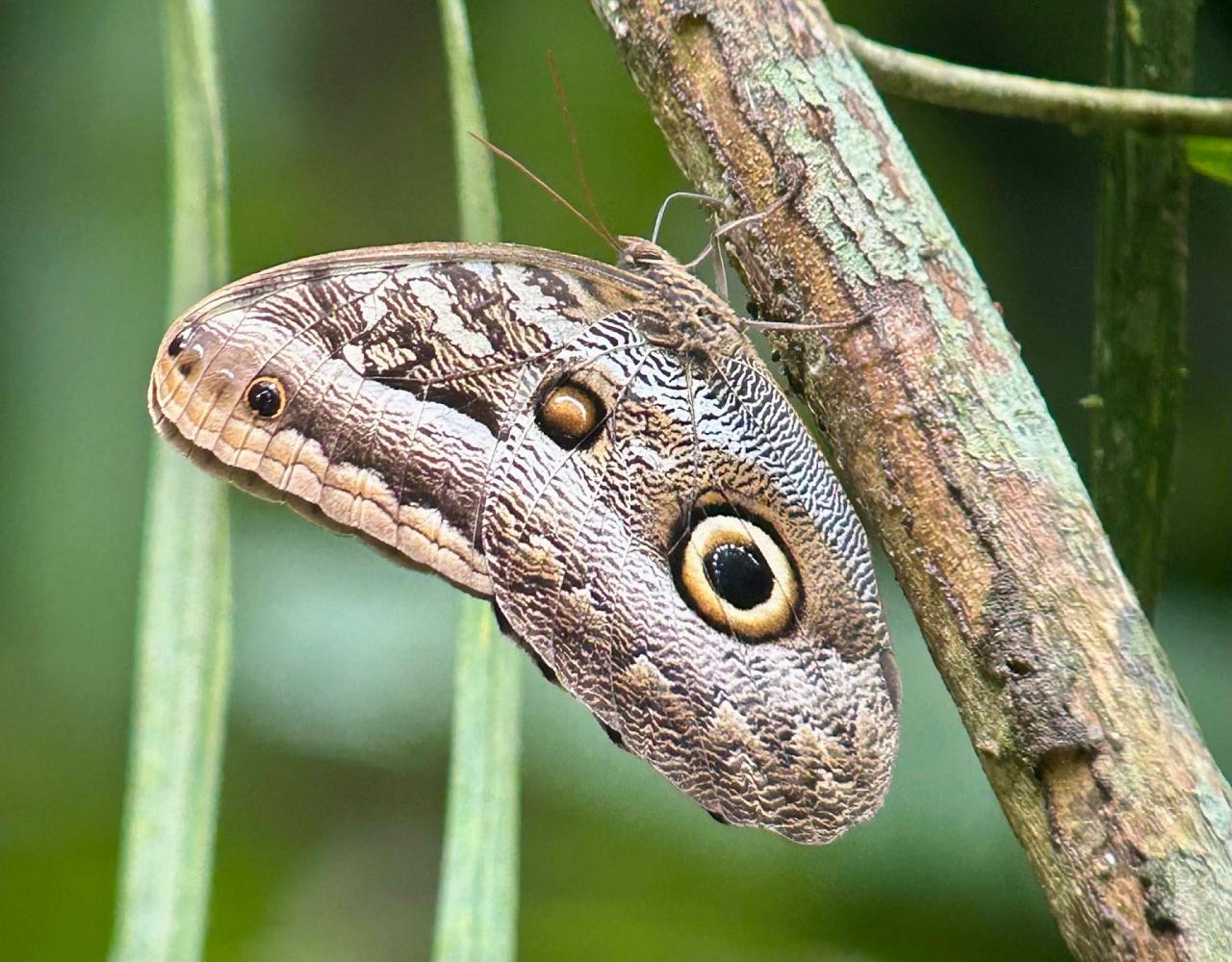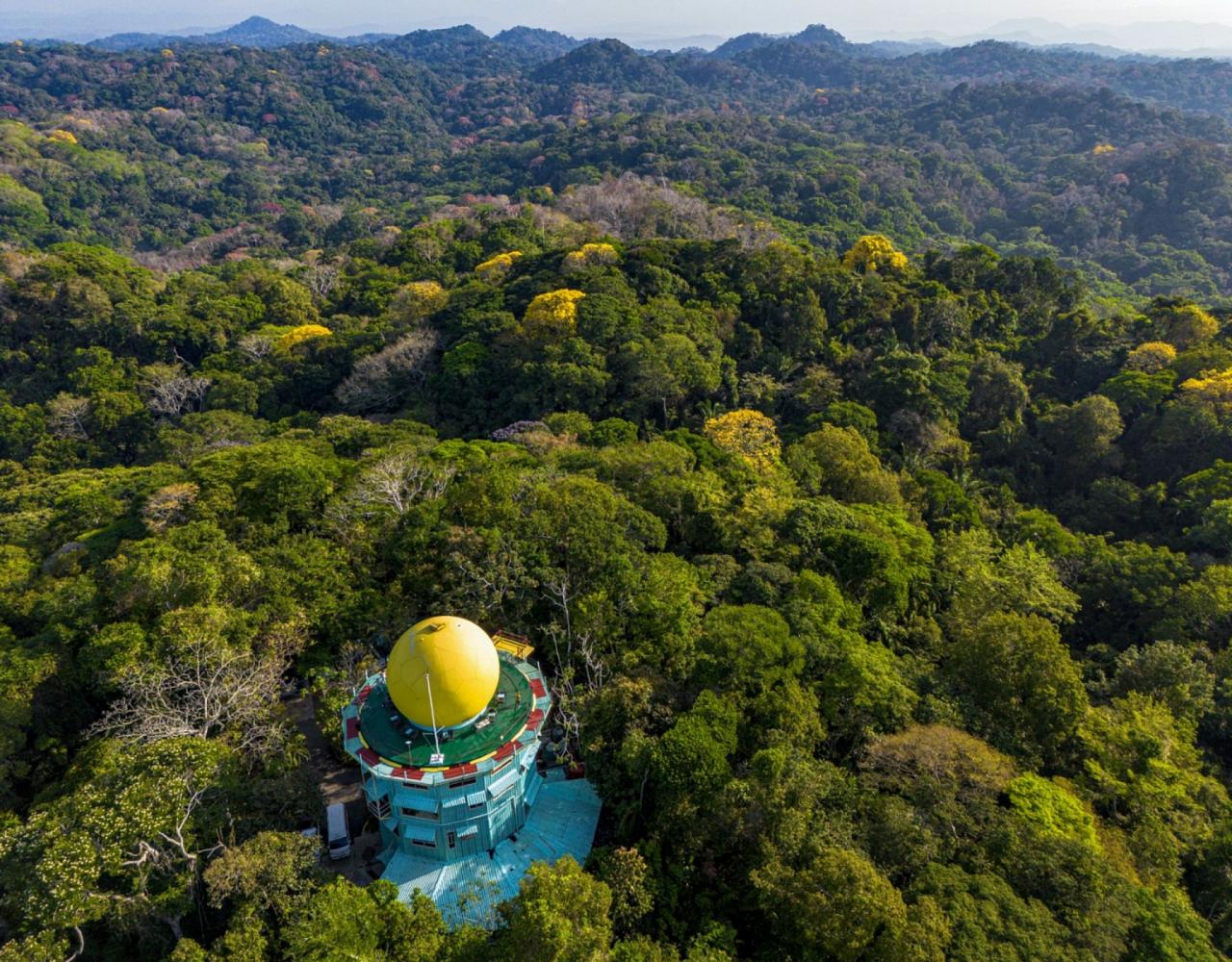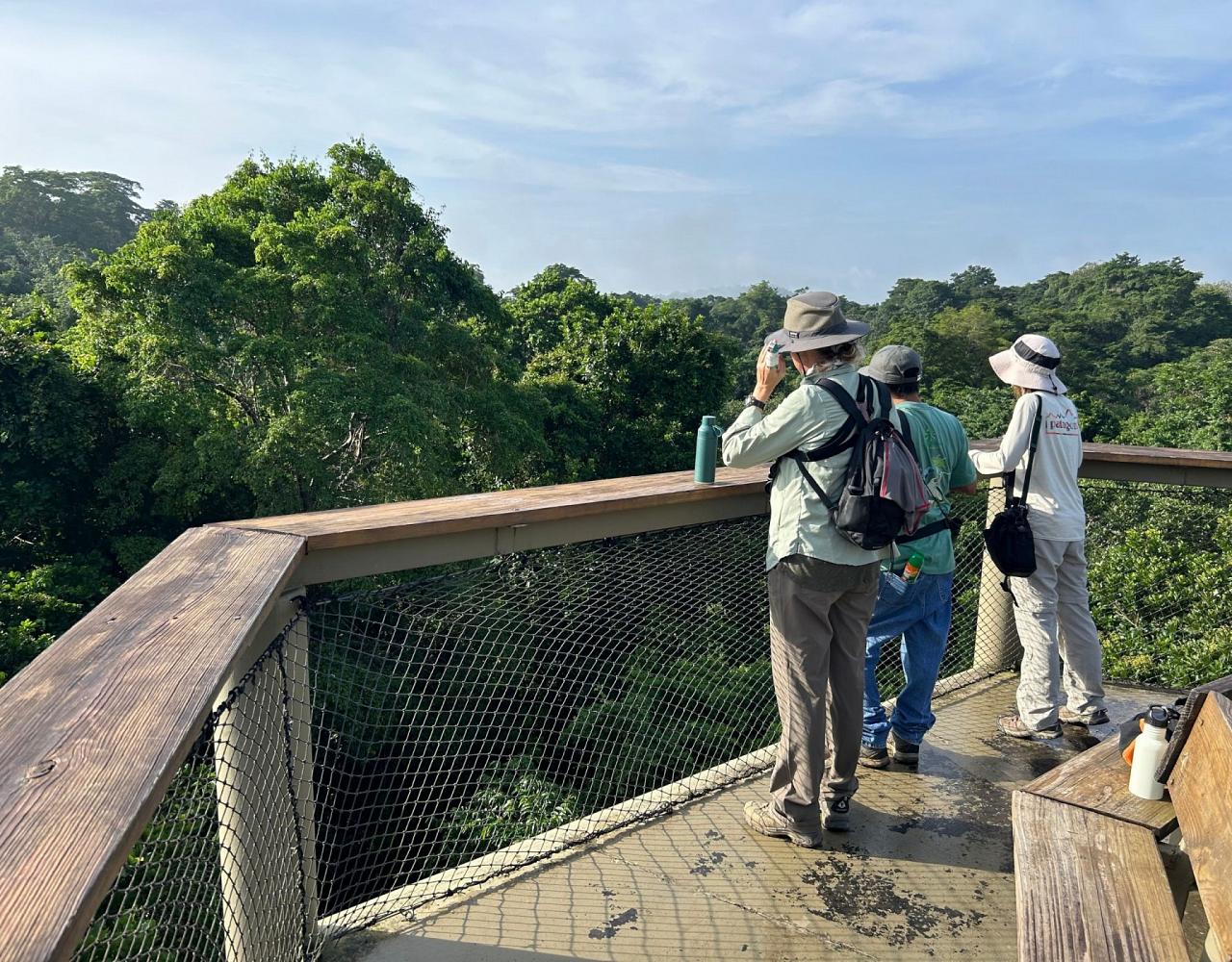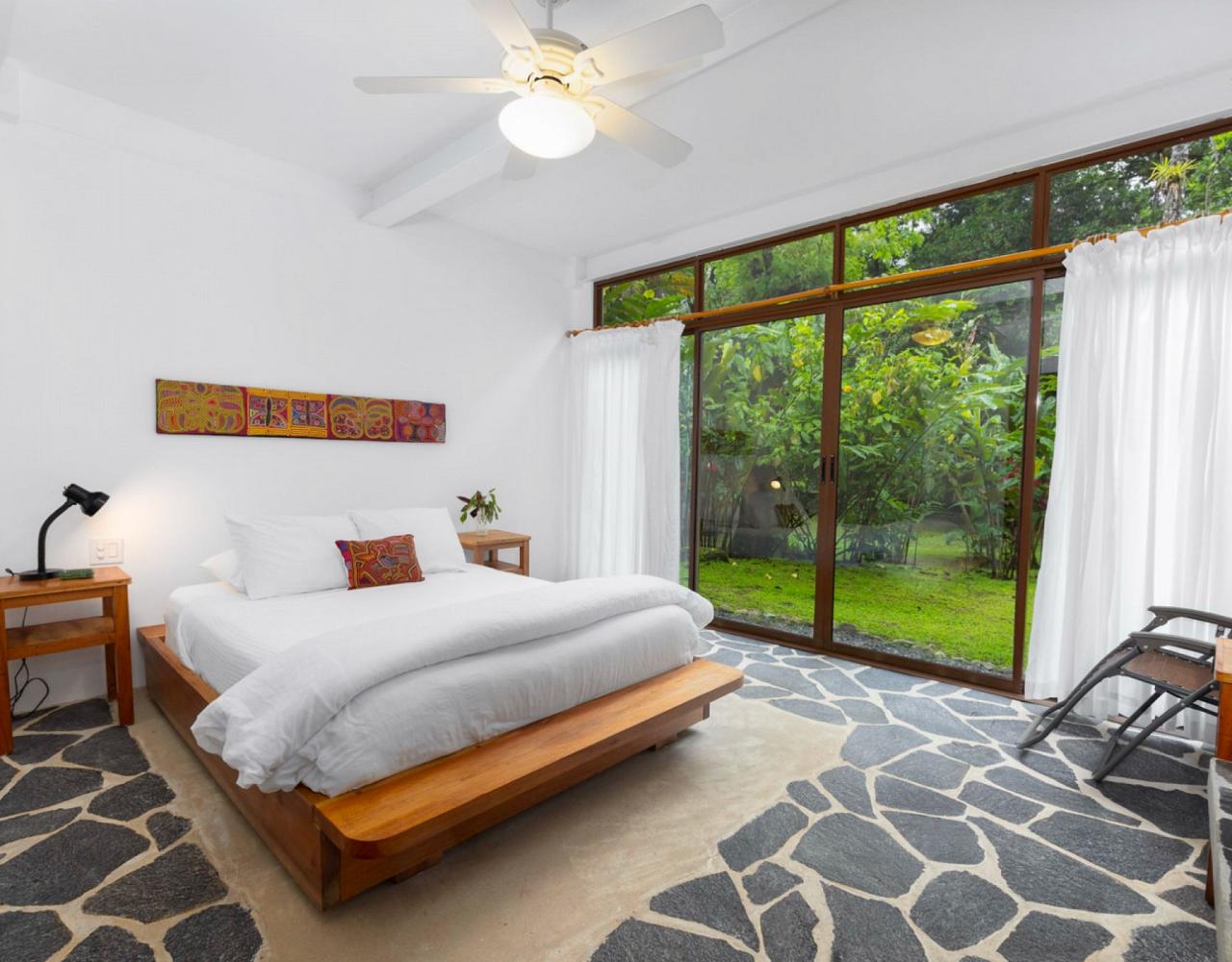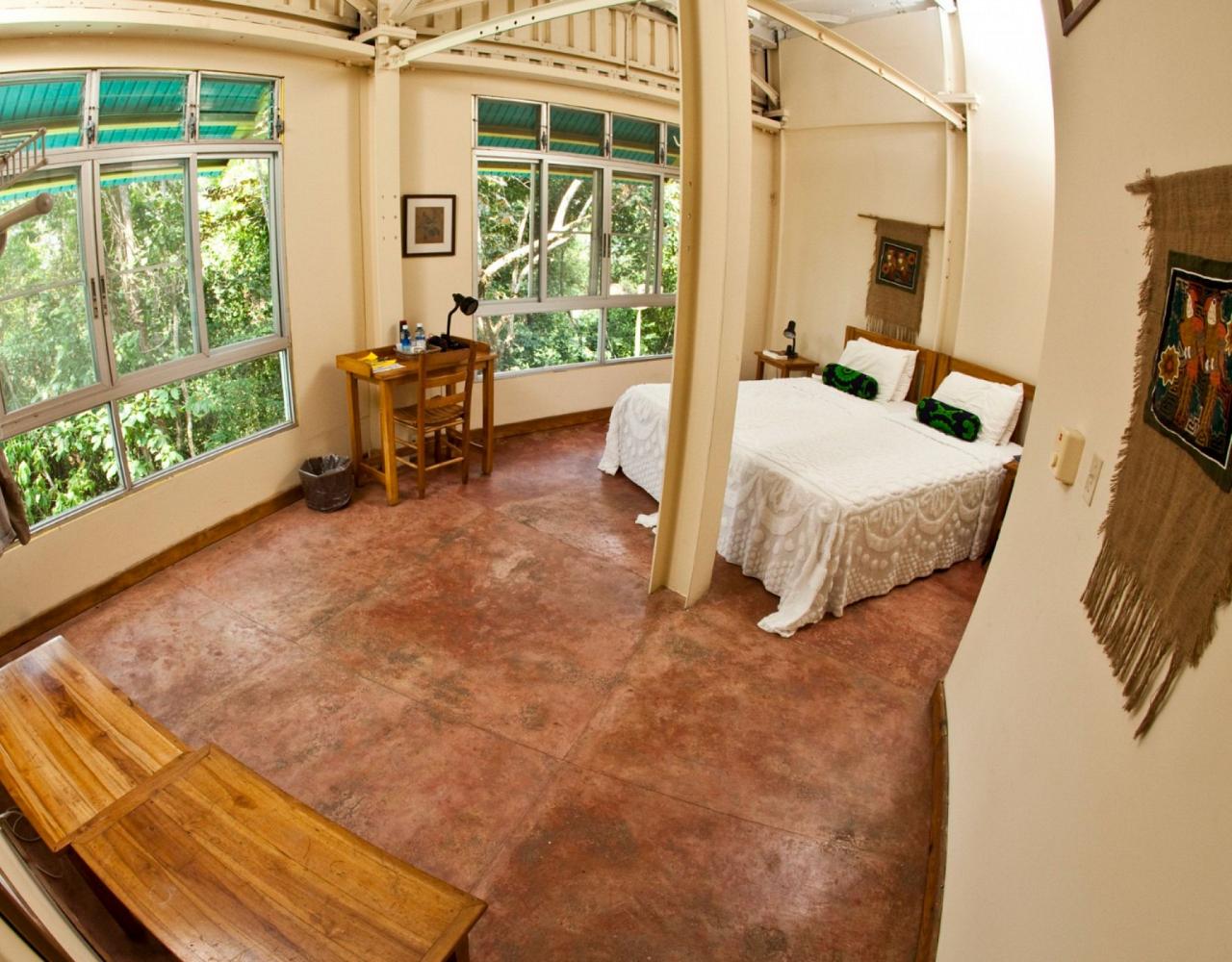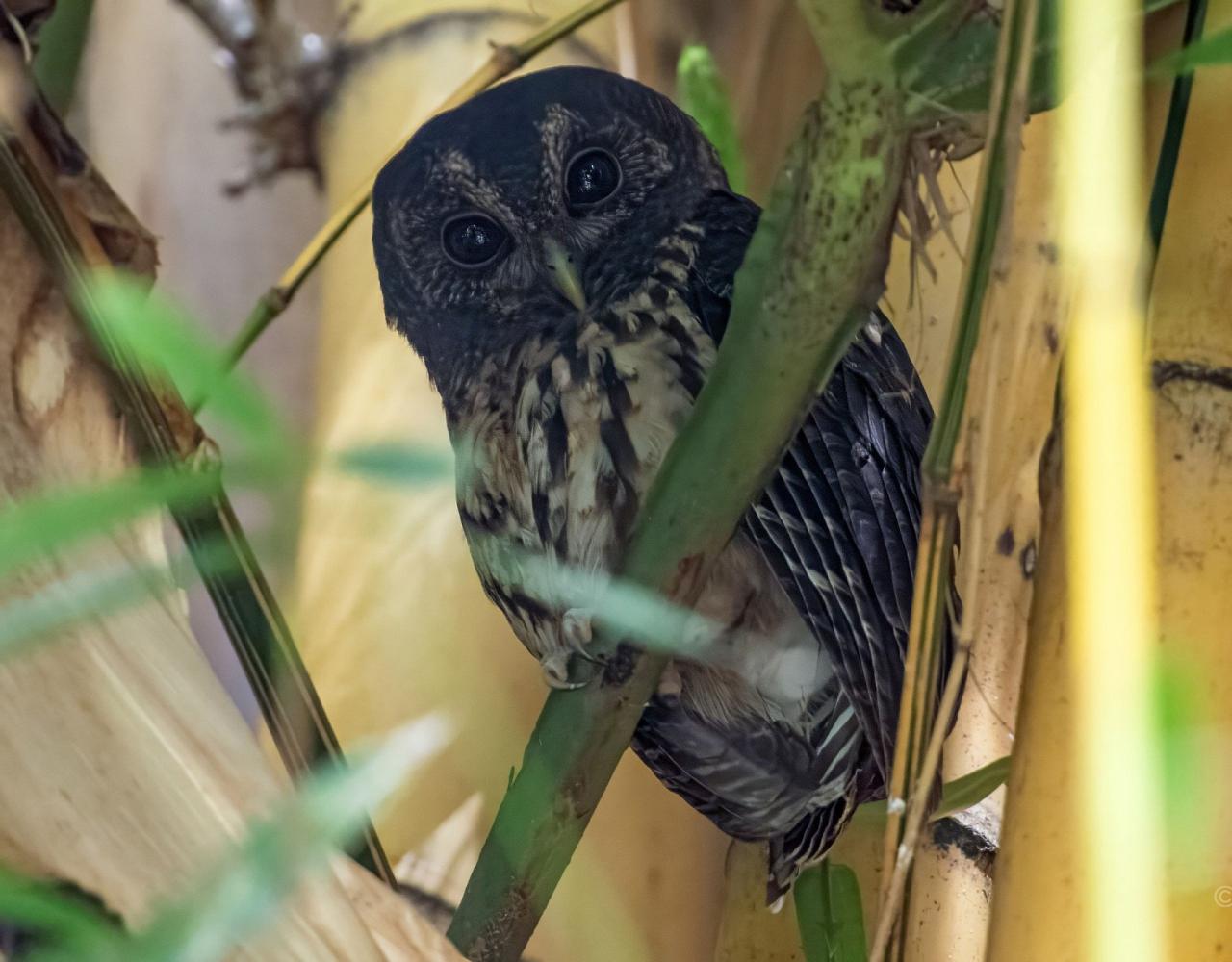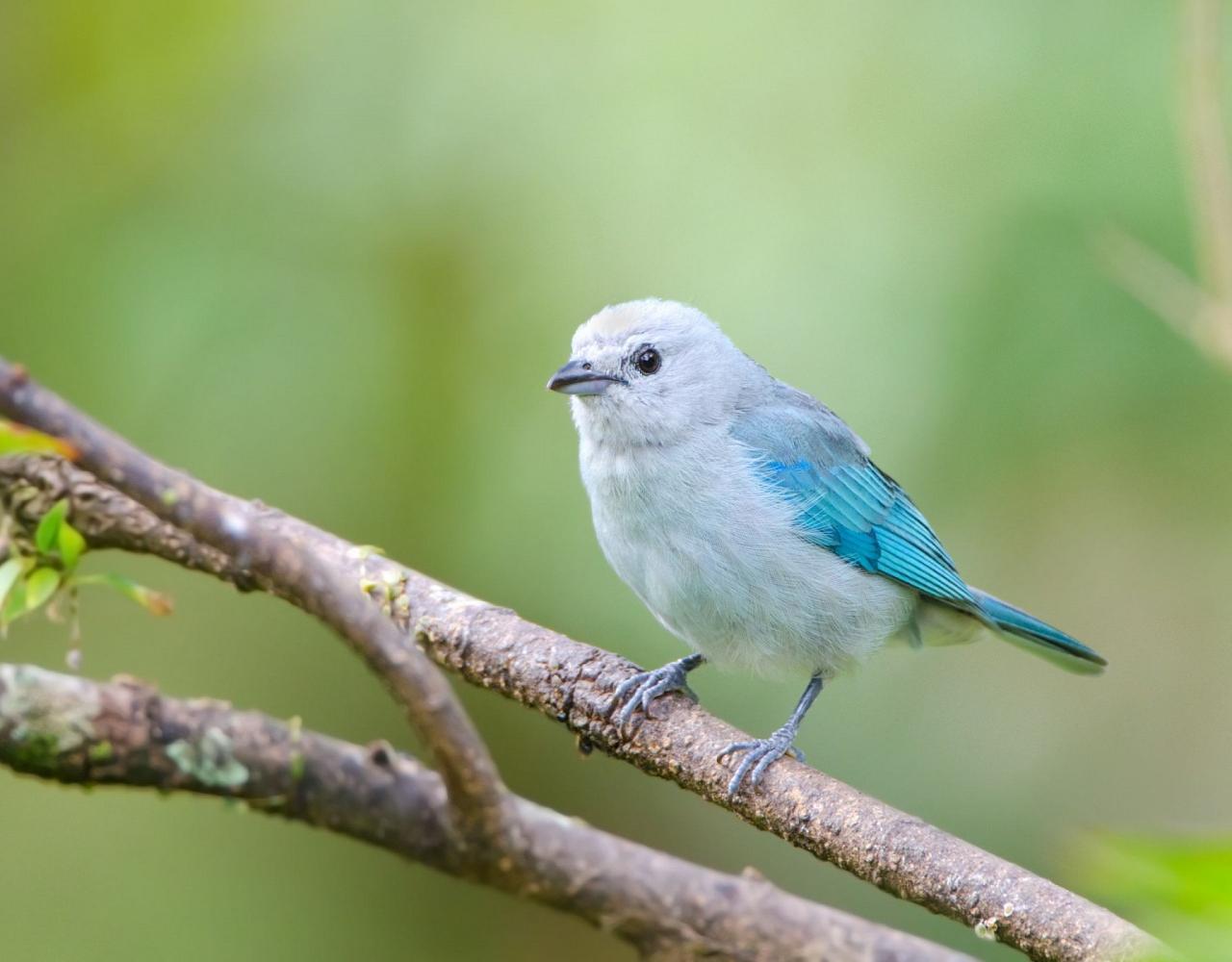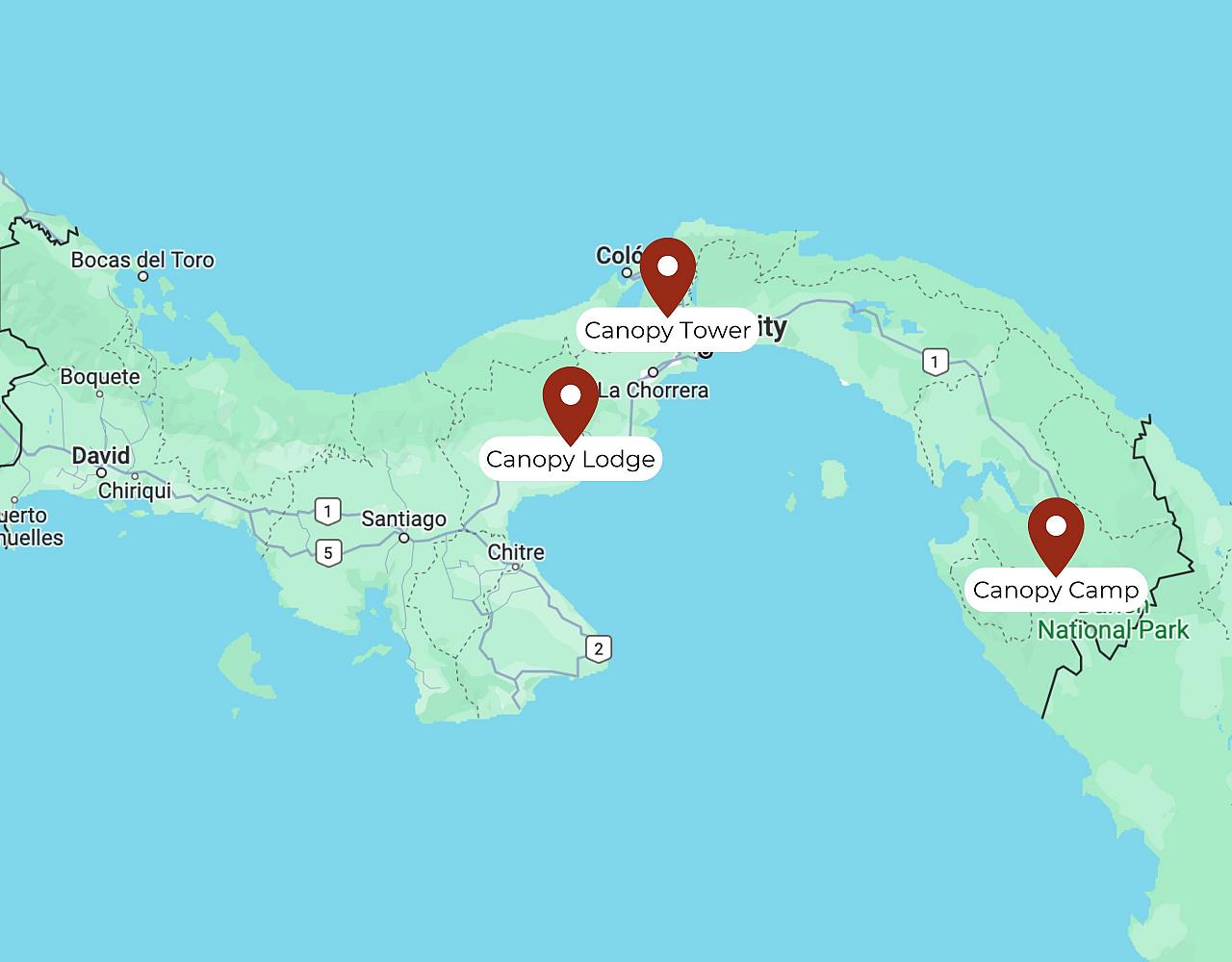- Overview
- Full Itinerary
- Photo Gallery
- Costing
- Travel Details
- Trip Reports
- Guide
- Map
- Know Before You Go
Discover Panama, where the wildlife of North and South America blend and the biodiversity is unmatched. On this Panama birding and nature tour, we explore the dense western jungles of Panama’s Darién region, long coveted, but only recently opened to birders. Canopy Camp Darién boasts modern amenities like large, safari-style tents, full-size beds, private baths and showers, flush toilets, solar electricity, and fans.
Then, live among the birds at Canopy Tower in Soberanía National Park, a repurposed radar tower ideally situated in a pristine portion of Panama’s lush lowland rainforest. The canopy-level dining area offers views of monkeys, toucans, sloths, mixed flocks, and more, right at eye level! There is also an upper deck, where you can take your morning coffee (or afternoon cocktail), for a 360° vista of the forest and a view of the Panama Canal. Early mornings on the top deck boast great views of raptors and parrots taking flight for the day.
Finally, venture off to the mountains, to enjoy one of the nicest eco-lodges in the Neotropics: the Canopy Lodge. Awaken to bird calls in the cool mountain air, with wisps of cloud forest fog creeping over the property’s flowing stream. With coffee in hand, view aracaris, motmots, oropendolas, honeycreepers, and warblers at feeders before breakfast. There are trails above and below the lodge that let us explore El Valle de Antón in detail.
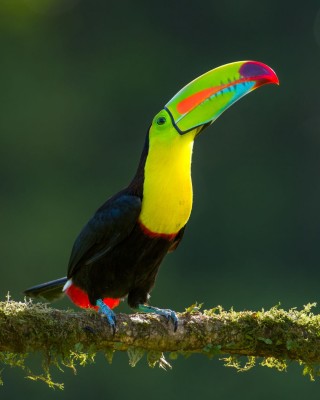

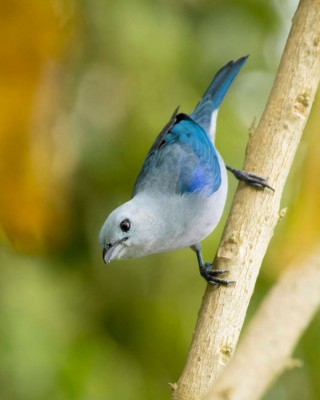
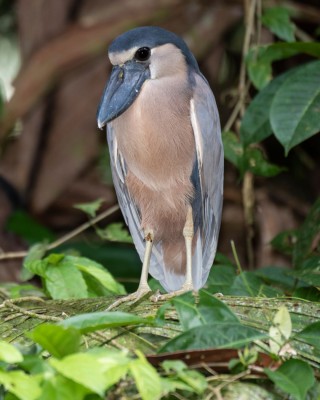
Tour Highlights
- Bird Canopy Camp’s trails for local specialties like Black Antshrike, Double-banded Graytail, Gray-cheeked Nunlet, Yellow-breasted Flycatcher, and Russet-winged Schiffornis
- Explore near Yaviza, at the end of the Pan-American Highway and less than 50km from Colombia
- Search for night birds near camp, including Striped, Crested, Barn, Black-and-white, and Mottled Owls, as well as Common and Great Potoos
- Visit Nuevo Vigia, located on the banks of the Rio Chucunaque, accessible by piragua (locally made dugout canoes)
- Immerse yourself in wildlife—on a walk, or from your balcony or hammock ...
- Cross Gatun Lake to explore the Panama Canal by boat
- Find antbirds, Pheasant Cuckoo, and other secretive species along Panama’s famous Pipeline Road
- Observe Geoffroy’s Tamarin and Mantled Howler Monkey eye-to-eye
- Bird in style from Canopy Tower’s open-air “Birdmobile”? Yes!
- Visit a colorful market for souvenirs and a conservation facility to see rare frogs
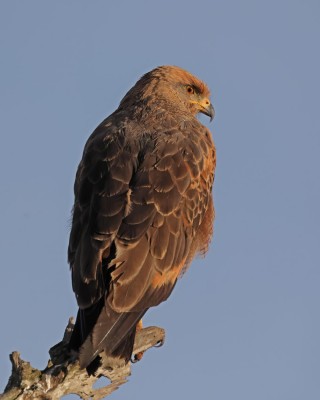
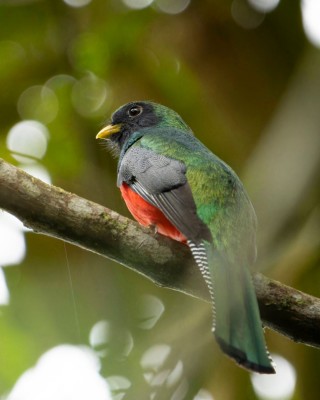
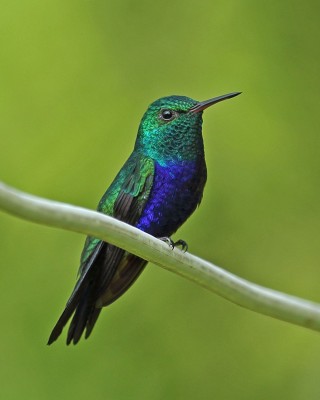

Trip Itinerary
Itineraries are guidelines; variations in itinerary may occur to account for weather, road conditions, closures, etc. and to maximize your experience.
Sun., July 6: Arrival in Panama
Today you arrive in Central America’s southernmost country! While you acclimatize to the tropical heat and have a cold drink, you can birdwatch right on the grounds of the hotel. Great-tailed Grackle, Clay-colored Thrush, Variable Seedeater, Tropical Kingbird, Blue-gray Tanager, Rufous-tailed Hummingbird, and more await your visit in the gardens.
Those arriving in time can join your tour host for dinner. We meet our expert local guides tomorrow.
Accommodations at Riande Aeropuerto Hotel (D)
Mon., July 7: Bayano | Canopy Camp Darién
This morning we enjoy breakfast in the hotel restaurant, featuring fresh tropical fruits and juices. Our local guide arrives to answer any questions you may have. Soon after breakfast we head for eastern Panama, where a host of great birds and plenty of exploring await! The journey to the Camp is approximately five hours, and we make stops along the way in exciting birding areas. As we drive east along the Pan-American Highway we scan for roadside birds and open-field raptors, including Savanna Hawk and Crested Caracara. Our first scheduled stop is Lake Bayano. This reservoir supports a variety of water birds, including Neotropic Cormorant, Anhinga, Cocoi Heron, and the rare Bare-throated Tiger-Heron. We scan the water’s edge for Purple Gallinule, Pied Water-Tyrant, Smooth-billed Ani, and Ruddy-breasted Seedeater. A short trail leading from the water’s edge is a good place to search for Black Antshrike, Bare-crowned Antbird, Rufous-winged Antwren, and Golden-collared Manakin. Just ten minutes down the road at Río Mono Bridge the surrounding forest is home to One-colored Becard, Black-headed Tody-Flycatcher, Blue Cotinga, Pied Puffbird, Orange crowned Oriole, Blue Ground Dove, and more. We also check the river below for Green-and-rufous Kingfisher and the elusive Fasciated Tiger-Heron. Further along the forest edge and scrubby roadside around Rio Tortí offer good opportunities to see Pacific Antwren, Double-banded Graytail and Little Cuckoo. At our lunch restaurant in Tortí the hummingbirds at the feeders capture our attention, as Long-billed Starthroat, Black-throated Mango, Sapphire throated, Scaly-breasted and Snowy-bellied Hummingbirds often share the gardens for lunch as well!.
Continuing east on the Pan-American Highway the passport check at the Darién provincial border reminds us that we are entering a more remote part of Panama. We continue on to Canopy Camp Darién, settle into our spacious tents then gather for an overview of the camp and the days to come. Relaxing over sundowners is a tradition here, and we take this opportunity to do our first checklist. After a delicious dinner of fresh American and Panamanian fare we return to our tents for the night, listening to the frogs, insects and perhaps an owl calling.
Accommodations at Canopy Camp (B,L,D)
Tues., July 8 - Thurs., July 10: Three Full Days at Canopy Camp
Most mornings start with a sunrise (or before!) coffee or tea and the dawn chorus of unfamiliar bird songs, including the mellow “wolf-whistle” of the handsome Barred Puffbird. Yellow-throated and Keel-billed Toucans call from the towering Cuipo trees; Red-lored and Mealy Parrots fly overhead; and White-bellied Antbird, Bright-rumped Attila, White-headed Wren, Golden-headed Manakin, and Rufous-tailed Jacamar sing from the surrounding forests, while Pale-bellied Hermit and Sapphire-throated Hummingbird visit the flowers around camp. By the 7:30am breakfast call we are ready to refuel! We explore many locations during our days here. The following are some of the areas we plan to visit during our time at camp. Please note that the itinerary is flexible, and may change without prior notice due to weather, alterations in habitat, or other conditions.
Accommodations at Canopy Camp (B,L,D)
Canopy Camp Grounds & Nando’s Trail
In the open areas the verbenas are full of hummingbird and butterfly activity, where we hope to see Violet-bellied Hummingbird, Long-billed Starthroat, Blue-throated Goldentail, and if lucky the stunning Ruby-Topaz Hummingbird. We work our way into the forest on “Nando’s Trail” in hopes of finding Tiny Hawk, Black Antshrike, Great Antshrike, Olive-backed Quail-Dove, Cinnamon Becard, Black-tailed Trogon, Double-banded Graytail, Gray-cheeked Nunlet, Yellow-breasted Flycatcher, and Russet-winged Schiffornis. We look for groups of noisy Red-throated Caracara in the trees and King Vulture and Short-tailed Hawk flying overhead. Some nights we search of nocturnal birds and mammals, including Black-and-white and Mottled Owls, Great and Common Potoos, Kinkajous, Central American Woolly Opossum, and more!
Birding the Pan-American Highway
We head southeast and bird the forests and swampy meadows along the road toward Yaviza, the end of the Pan-American Highway in North America. Black-billed Flycatcher, Sooty-headed Tyrannulet, Jet Antbird, Black Oropendola, Bicolored and Black-collared Hawks, Pearl and White-tailed Kites, Limpkin, Spot-breasted Woodpecker and Ruddy-breasted Seedeater may all be found as we head further into Darién.
El Salto Road
El Salto Road extends 6 km north from the Pan-American Highway and ends at the mighty Río Chucunaque, the largest river in Panama. This open road and surrounding dry forest is a great place to search for regional specialties including Golden-green Woodpecker, Double-banded Graytail, Blue-and-yellow and Chestnut-fronted Macaws, Black and Crested Oropendolas, Blue Cotinga, White-eared Conebill, Black-breasted Puffbird, Orange-crowned Oriole, and the majestic King Vulture. A trail at the end of the road takes us into low-canopy forest, where we hope to find Bare-crowned Antbird, Pale-bellied Hermit, Olivaceous Piculet, and Forest Elaenia.
Tierra Nueva Foundation
Adjacent to El Salto Road is the property of the Tierra Nueva Foundation. Fundación Tierra Nueva is a non-profit organization whose main mission is working towards the sustainable development of people of the Darién Rainforest. We explore the trails of this large, forested property, in hopes of finding Streak-headed Woodcreeper, Yellow-breasted and Black-billed Flycatchers, Red-rumped Woodpecker, Slaty-backed Forest-Falcon, Cinnamon, Cinereous and One-colored Becards, White-eared Conebill, White-headed Wren, and the magnificent Great Curassow. We also search for the eastern Short-tailed subspecies of the widespread Chestnut-backed Antbird, which shows white spots on the wings and is shared with adjacent Colombia.
Quebrada Felix
Quebrada Felix is nestled at the base of the Filo del Tallo Hydrological Reserve, just a short drive from the Canopy Camp. Surrounded by tall trees and mature lowland forest, we walk the rocky stream in search of some of Panama’s most wanted species, including Black-crowned Antpitta, Scaly-throated Leaftosser, Speckled Mourner, Ocellated Antbird, Rufous-winged and Moustached Antwrens, White-fronted Nunbird, Wedge-billed Woodcreeper, Royal Flycatcher, and the endemic Stripe-cheeked Woodpecker. It is also a good spot to find Fasciated Tiger-Heron, Green-and-rufous Kingfisher, Bicolored Antbird, Golden-crowned Spadebill and Double-banded Graytail. Crested and Solitary Eagles have even been spotted here, a testament to the mature forest of the area.
Nuevo Vigia
Nuevo Vigia, an Embera community nestled north of the Pan-American Highway, is surrounded by secondary growth dry forest and two small lakes, all of which attracts an enticing variety of birds. We access the community by piragua. As we coast along the Chucunaque and Tuquesa Rivers we keep our eyes and ears open for Chestnut-backed, Crested and Black Oropendolas, Common Black Hawk, Yellow-tailed Oriole, Red-billed Scythebill, Capped and Cocoi Herons, Greater Ani and other water-associated birds. After arrival we bird a trail from the community toward a small lagoon, a great place to see Black-collared Hawk, Bare-crowned and White-bellied Antbirds, Green Ibis, Gray-cheeked Nunlet, Spectacled Parrotlet, Black-tailed Trogon, Striped Cuckoo, Black-bellied Wren, Little Tinamou, Golden-green Woodpecker and Green-and-rufous Kingfisher. Black-capped Donacobious has recently colonized this area as well. Local artisans weave colorful decorative masks and plates out of palm fronds and carve cocobolo wood and tagua nuts into animals and plants; we have the opportunity to meet some of the community members and admire and purchase some of their beautiful products. We enjoy a picnic lunch in the village, then head back to Camp, birding along the way.
San Francisco Reserve
San Francisco Nature Reserve is a private forest reserve owned and managed by the St. Francis Foundation, covering 1,300 acres in eastern Panama Province. The Reserve and Foundation were established in 2001 by Father Pablo Kasuboski, an American priest from Wisconsin who came to Panama in 1988. The reserve serves as a wildlife refuge and protects the headwaters of the main rivers of the area. The St. Francis Foundation also works on infrastructure development in the area by building and maintaining aqueducts, roads, schools, and churches; the Foundation built and maintains the largest private rural aqueduct in all of Panama and Central America. The reserve has a variety of habitats including primary, secondary, and riparian forests, forest edge, fields, farmland, ponds, and wetlands. During our morning here we explore some of the different habitats along the short road that enters the reserve. We hope to find Great Jacamar, Broad-billed Motmot, Collared Aracari, Sulphur-rumped Tanager, Russet-winged Schiffornis, White-fronted Nunbird, Brownish Twistwing, endemic Yellow-green Tyrannulet, Central American Pygmy-Owl, Blue and Plain-breasted Ground Doves. If we’re very lucky a Black-and-white Hawk-Eagle may soar overhead or a Wing-banded Antbird appear along the trail.
Fri., July 11: Morning Birding | Travel to Canopy Tower
We enjoy breakfast and the birds at Canopy Camp as the sun rises, and if time allows, chose one more birding site to explore before birding our way back to Panama City and onward to Canopy Tower.
Over the next few days, the Canal is ever present, providing a great opportunity to understand its operations (past and contemporary), recent expansion, and role in Panama’s economy.
On arrival, we walk down the hill for our first bird sightings. Lush forests line the road to the Tower—we never know what we may find! Black-breasted Puffbird, Double-toothed Kite, Black-tailed or other trogons, secretive antbirds or wrens, Geoffroy’s Tamarin, and more are possible. This is a leisurely walk downhill, and the lodge’s open-air vehicle awaits us at the bottom to take us back to the Tower. If you wish, opt out and simply enjoy watching hummingbirds vie for nectar at the feeders near the lodge.
We then settle into one of the most unusual eco-lodges, and before a delicious dinner we may gather on the observation deck to watch the sunset and ships passing through the Panama Canal—spectacular!
Accommodations at Canopy Tower (B,L,D)
Sat., July 12: Soberanía National Park | Pipeline Road | Ammo Dump Pond
Soberanía National Park is considered one of Central America’s most spectacular and accessible areas for bird watching and wildlife observation. Only 45 minutes from Panama City, Soberanía's 55,000 acres boast some 525 species of birds, 105 species of mammals (including large cats), Tamandua (a type of anteater), both Two and Three-toed Sloths, four species of monkeys, Central American Agouti, and 59 endemic plant species that inhabit four life zones. We depart early to get out on Pipeline Road when bird activity is most lively.
A walk along the world-renowned Pipeline Road is unforgettable, a prized destination among birdwatchers and nature enthusiasts. During World War II, a pipeline was built along the Panama Canal to transport fuel from one ocean to the other in the event the waterway was attacked. Fortunately, it was never used. The road, not open to traffic, provides a lush, easy pathway for us to explore. This is the site where the Audubon Society held its world record Christmas Bird Count for 19 years straight, identifying 357 species of birds in a 24 hour period. This morning we look for secretive antbirds such as White-flanked and Pygmy Antwrens, and other rainforest birds such as Great Jacamar, Broad-billed Motmot, Blue-crowned and Golden-collared Manakins, Pheasant Cuckoo, Brown Twistwing, and some of the rarer forest raptors. We likely encounter the tropical phenomenon of the mixed flock—a veritable explosion of birds that work and feed together, exhibiting complex social structure that scientists are only beginning to understand. Insect watchers may find iridescent beetles, beautiful clearwing butterflies, colorful grasshoppers, or even the world’s largest damselfly.
We return to the Tower for lunch and a mid-day break, then venture out to the very productive Ammo Dump Pond, where we hope to find Northern Jacana, Rufescent Tiger-Heron, Black-bellied Whistling-Duck, Yellow-tailed Oriole, Lesser Kiskadee, possibly Pygmy Kingfisher, and other interesting species.
Accommodations at Canopy Tower (B,L,D)
Sun., July 13: Panama Canal Rainforest Boat Adventure | Gamboa History | Summit Ponds
This morning you can sleep in a bit … if you are able to over the sounds of the forest just outside your door! Others may want to watch the sunrise with a good cup of Panamanian coffee from the observation deck.
After breakfast, we explore the waters of the Panama Canal on small boats, quietly moving through coves and inlets in search of wildlife, including Greater Ani, Snail Kite, other raptors, and possibly whistling-ducks, reptiles such as Spectacled Caiman and Green Iguana, and both Mantled Howler and White-faced Capuchin Monkeys. We find this to be the most comfortable and accessible way to discover the natural attributes of the Panama Canal watershed. We have the freedom to explore Gatun Lake in detail, passing by gigantic cargo ships transiting the waterway. Along the way, we should spot Three-toed Sloth resting on tree branches, while Osprey are vocal and on the prowl for Peacock Bass. Limpkin, Anhinga, and Keel-billed Toucan are some of the birds we may encounter.
This is also a great place to focus on some history. At the time of its creation, Gatun Lake was the largest man-made lake in the world. The flow of all the rivers within the Panama Canal Watershed is contained in Gatun Lake to provide water for the operation of the lock system. More than 52-million gallons of fresh water are used for every ship that transits through the Panama Canal from one ocean to another.
In 1902 (33 years after the Suez Canal was opened), after years of negotiation and a disastrous attempt by the French to build the canal, the U.S. Congress authorized construction of the Panama Canal. The project was put on hold, however, when Colombia, which controlled Panama at the time, rejected the authorizing treaty. It was only in 1904, after Panama’s independence, that construction began. Ten years later, ahead of time and under budget, the Canal was opened to bridge the world. Imagine that first historic passage!
The year 2000 marked the end of the U.S. treaty (which had actually been revised several times) and Panama now assumes responsibility for operation of the Canal. In 2016, a third lock opened to accommodate increased traffic and larger ships. From our boats on Gatun Lake you can see the Titan Crane and learn more about the history of the town of Gamboa, which is still the Canal’s dredging operations center.
Mid-afternoon we visit Summit Ponds, a wonderful, leisurely birding area where even in the quiet time of afternoon we may find trogons, motmots, and a host of interesting species. Here, we are at the edge of open and forested areas, and good numbers of migrant warblers join resident Neotropical species, making it a very rewarding stop. The ponds themselves often provide us with nesting Boat-billed Heron, a nocturnal species that can be otherwise difficult to find.
We return to enjoy happy hour, dinner, and evening at the Tower.
Accommodations at Canopy Tower (B,L,D)
Mon., July 14: Discovery Tower | Pipeline Road
Today we return to nearby Pipeline Road, but this time we go very early to ascend the Discovery Tower for a special sunrise-viewing of birds high in the canopy. The views are incredible, and of note are parrots, raptors, and other species flying by as they leave their night roosts. Hummingbirds are busy in the canopy flowers, and we may find elusive puffbirds, woodpeckers, tanagers, and, with luck, the dazzling Blue Cotinga.
We come back to the Discovery Center display area for coffee and a chance to watch the hummingbird feeders. One year we found Night Monkeys peering out of their roost tree here, such a delight! We can walk another trail or part of the road after our coffee; the Pipeline area is so rich that there are always new species to observe. Black-tailed Trogon can be seen here, as well as the secretive Streak-chested Antpitta, Black-faced Antthrush, noisy Bright-rumped Attila, Red-capped Manakin, and Northern Schiffornis. We don’t want to miss any of them!
We return for lunch and a siesta, then in the afternoon we do some leisurely birding along the Chagres River and in the residential area of Gamboa, below Gamboa Rainforest Lodge, where lush plantings attract many species, from toucans to agoutis to colorful tanagers and more. Golden-fronted Greenlet, Cinnamon Becard, Golden-collared Manakin, Buff-breasted Wren, and Gray-headed Tanager are all possible in this area.
One of our evenings at the Tower we enjoy a night drive on which we look for Spectacled Owl and mammals like Allen’s Olingo, Woolly Opossum, and Kinkajou, which are often feeding on fruits and flowers. It’s a lot of fun to be under the immense canopy of rainforest trees as the night shift of wildlife gets active. Our skilled Tower guides are specialists in finding these mysterious jungle residents!
This is our last evening at the Tower and we gather on the observation deck for sunset and the sight of birds returning to roosts ahead of dinner.
Accommodations at the Canopy Tower (B,L,D)
Tues., July 15: Plantation Road | Canopy Lodge
By mid-morning we pack up and drive north to the other fabulous property operated by the Canopy Family—the Canopy Lodge near El Valle in the central mountains.
On arrival at Canopy Lodge, we find ourselves immersed in the beauty of mountain terrain where nature is active all around us. We quickly find a host of hummingbirds, tanagers, and oropendolas at feeders adjacent to the open-air dining area. We have close up views of tanagers: Flame-rumped, Crimson-backed, White-lined, and Blue-gray, as well as electric Red-legged Honeycreeper. Clay-colored Thrush, Streaked Saltator, and Yellow-faced Grassquit provide us with activity throughout our stay. Sometimes more secretive species such as Rufous Motmot or Orange-billed Sparrow emerge from the vegetation near the lodge!
We meet our local guides who are eager to share bird specialties on the forest trails leading from the Lodge. Occasionally, two often-difficult to see Neotropical species can be found here: Tody Motmot and Rufous-vented Ground-Cuckoo. Basilisk Lizard sun themselves on rocks along the stream, while Broad-billed and Rufous Motmots, Chestnut-backed Antbird, and the less common Dull-mantled Antbird are often present along the trail, and occasionally, we see the bizarre White-tipped Sicklebill. We hope in time to get views of the elusive Sunbittern that feeds along the stream that flows by the Lodge, too.
We relax and settle in. The food here is wonderful, as is the atmosphere for tonight’s meal. Enjoy!
Accommodations at the Canopy Lodge (B,L,D)
Wed., July 16: Cara Iguana | Rare Frog Conservation Facility | Canopy Lodge
There are so many wonderful places to bird right near the Canopy Lodge. Today we choose according to what species the guides are finding, and where. The secretive Tody Motmot is one option, often found on a road we like to walk along above a lovely residential district near town.
We do want to visit a facility for endangered frog research and propagation, housed at Hotel Campestre, with a wide selection of native animals and birds, mostly in good-sized cages. Some of you may already be familiar with the frog facility as it has been featured in a documentary on Public Television. In addition to learning about the many forms of frogs and the challenges they face, we spend some time birding here, too. It's a pleasant place to spend an hour wandering around. The secretive Rosy Thrush-Tanager is one bird we look for here, a lovely songster with black and raspberry-colored plumage! We also take time to visit the charming local farmers’ market where colorful vegetables and artisan crafts are found. This is a great chance to purchase any local souvenirs or gifts to take home.
Accommodations at Canopy Lodge (B,L,D)
Thurs., July 17: Exploring the Mountains at La Mesa & Las Minas Road
This morning we venture to higher elevation to watch birds near what might be the world’s most beautiful chicken farm. Walking into the forest, we have a chance to see some of the more secretive species, including mixed flocks of antwrens, Black-crowned Antpitta, and another chance for White-tipped Sicklebill.
Our plan is to walk atop La Mesa on Las Minas Road where we search for foothill species and hope to see one of our favorites: the comical Northern Emerald-Toucanet. In lush clusters of bromeliads that festoon the trees, we encounter Ochraceous Wren and Gray-breasted Wood-Wren; on tree trunks we search for both Plain-brown and Spotted Woodcreepers, and we listen for Red-faced Spinetail, which may sing out from roadside trees. Both White-throated and Pale-vented Thrushes can be found along our route, as well as mixed groups of beautiful tanagers like Silver-throated. Masked Tityra often call from treetops at the road’s edge and Black-headed Saltator, Tawny-capped and White-vented Euphonias, and Spot-crowned Barbet have been seen at local feeders! Those who prefer hiking to birding can simply walk farther along this scenic mountain road, returning to join us at a specified time.
We return to the lodge for lunch and a break. Relax on your porch, browse books in the open-air library, or wander the grounds where Stripe-throated Hermit, and Violet-headed and Rufous-tailed Hummingbirds visit purple verbena flowers. You may even glimpse the rare Rufous-crested Coquette! We may hear the beautiful cascading notes of an Orange-billed Nightingale-Thrush or watch a mixed flock come through, perhaps with a beautiful Bay-headed Tanager. Along a stream that runs through the property we watch for Green Kingfisher, possible Sunbittern, Buff-rumped Warbler, and a host of colorful butterflies, including the brilliant Blue Morpho. A Three-toed Sloth may be seen draped lazily across an open branch or peeking out from behind the large leaves of a Cecropia tree.
On our last afternoon, we take a leisurely walk up the road or on trails right from the lodge. Our local guides know where to find the best and most current sightings. Trees surrounding the lodge serve as perches for a good diversity of flycatchers, including Southern Beardless-Tyrannulet, Lesser and Yellow-bellied Elaenias, and Boat-billed, Social, and Piratic Flycatchers. During the dry season, raucous Chestnut-headed Oropendola nest in a colony in the tall Eucalyptus trees in the yard, while Giant Cowbird sometime show up looking for an unguarded nest in which to deposit an egg.
Birding along the road near the lodge, we have a good chance of hearing and seeing many species typical of the dry Pacific slope: Lesson's Motmot, Lance-tailed Manakin (difficult to see), Rosy Thrush-Tanager, and Red-throated Ant-Tanager. Humid foothill species are also present, including Orange-billed Nightingale-Thrush, and Dusky-faced and Tawny-crested Tanagers. Watch for larger species like the noisy Gray-headed Chachalaca, Keel-billed Toucan, Collared Aracari, and Black-chested Jay. It is also worthwhile to keep an eye on the sky, in case a White Hawk or Black Hawk-Eagle passes overhead.
This evening we have a wrap-up over happy hour to list our trip highlights, tally the species we’ve seen, and enjoy a celebratory dinner at the lodge.
Accommodations at Canopy Lodge (B,L,D)
Fri., July 18: Departures from Panama City
We enjoy one last morning with nature as our alarm clock before heading off to the airport. Important! We have a three-hour return trip to the airport, so we ask that you book flights out after NOON. Those electing to leave earlier need to pay for a special transfer, with your start time set so that you have at least two hours at the airport. If you just can’t bear to leave yet, you can book additional days here and enjoy a field trip up to Altos Las Marias by 4WD, or simply relax. (B)
Cost of the Journey
The cost of this 12-night journey is per person, based on occupancy: $5590 DBL / $5890 SGL, from Panama City. This cost includes 12 nights’ accommodations; meals as specified in the itinerary, group departure airport transfers, professional guide services, local park and other area entrance fees, and miscellaneous program expenses. Singles are limited, so please inquire promptly if interested. The cost does not include transportation to or from your home to Panama, or items of a personal nature such as laundry, telephone charges, porterage, maid gratuities or beverages from the bar.
Travel Details
Please plan to make air travel plans only after the minimum group size has been met. We will send you a confirmation email as soon as the trip has been confirmed.
Arrival and Departure Airport: Tocumen International Airport (PTY) in Panama City
Arrival Details: Plan flights to arrive July 6, 2025 at your leisure. Please plan on taking the free Riande Airport Hotel airport shuttle when you arrive.
Departure Details: Plan flights to depart July 18, after 12:00 PM. We have a 2.5-3 hour drive to the airport on our last day so please make sure flights departures are no earlier than 12:00 PM
Travel Tips: If you arrive early to rest up from your travels, you can book an early night at our first night tour hotel, the Riande Airport Hotel. If you want to explore a bit, there are a few things to see that aren’t far from the hotel. The Panama Canal Museum has exhibits on the history of the construction of the Panama Canal. The Archeology Site of Panama Viejo, including the museum, is fascinating to visit. Panama Viejo was the first European settlement along the Pacific and founded in 1519. It was later destroyed by Captain Morgan in 1671. Ruins remain from buildings constructed in the 1600s. Both of these sites are 20-25 minutes from the hotel and can be reached by taxi or Uber.
Entry Requirements: See "Essential Information" section under the "Know Before You Go" tab.
Browse below for trip reports and species lists from past versions of this and other tours from this destination.
Panama
- February 2011
- March 2012
- January 2013
- February 2015
- January 2018
- January 2019
- January 2020
- January 2020
- October 2021
Birds & Mammals
- February 2019
- February 2020
- April 2022
- March 2023
- March 2024
- March 2025
Darién
- February 2016
- March 2017
- July 2019
- July 2022
- July 2023
Green Season
- July 2012
- August 2014
- July 2019
- July 2024 (Three Lodge Tour)
Intro to Biodiversity
- October 2019
- October 2021
- September 2023
- September 2024
Tranquilo Bay
- January 2022
- April 2022
- October 2022
- January 2023
- March 2023
- April 2023
- October 2023
- January 2024
- February 2024
- March 2024
- April 2024
- October 2024
- November 2024
- January 2025
- February 2025
- March 2025
-
Rick Weiman

Rick lives in Oakland, NJ with his wife Patricia and two adult children, Jack and Annabel. Rick has led birding trips for a number of years as a volunteer for various local nonprofits, and for Oakland residents in his town's 40-acre Great Oak Park. For over 30 years he has counted birds on annual big days to raise dollars for endangered species recovery efforts in his home state. His passion for conservation started during his college years at Rutgers where he majored in Biology, and he has been a trustee of the Conserve Wildlife Foundation of NJ since 2000. His volunteer and fundraising efforts for The Raptor Trust, the largest wild bird rehabilitation center on the east coast, resulted in his addition to their board of trustees in 2018. One of his favorite areas to visit is Central America and he has hosted tours for Naturalist Journeys in Costa Rica, Panama, Guatemala, and Belize. In his spare time besides birding, Rick enjoys playing street hockey, fishing, and visiting the jersey shore, especially Cape May.
Photo credit: Hugh Simmons
Other trips with Rick Weiman
-
 Cape May: Spring Migration FULL - See our fall departures!May 13 - 19, 2025
Cape May: Spring Migration FULL - See our fall departures!May 13 - 19, 2025 -
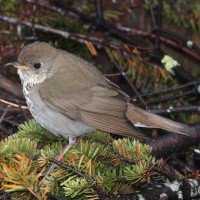 New Hampshire's Mt. Washington Warblers & Bicknell's ThrushJune 4 - 10, 2025
New Hampshire's Mt. Washington Warblers & Bicknell's ThrushJune 4 - 10, 2025 -
 Olympic Peninsula Fall Explorer FULL - Check out Vancouver Island: Coastal Birds, Bears & Whales!September 4 - 11, 2025
Olympic Peninsula Fall Explorer FULL - Check out Vancouver Island: Coastal Birds, Bears & Whales!September 4 - 11, 2025 -
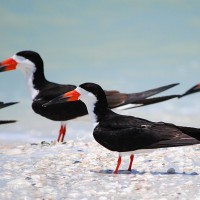 Cape May: Fall MigrationOctober 7 - 13, 2025
Cape May: Fall MigrationOctober 7 - 13, 2025 -
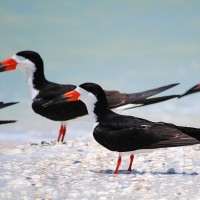 Cape May: Fall MigrationOctober 14 - 20, 2025
Cape May: Fall MigrationOctober 14 - 20, 2025 -
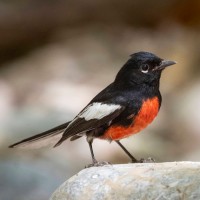 Southeast Arizona: Sky Island Fall SamplerNovember 2 - 9, 2025
Southeast Arizona: Sky Island Fall SamplerNovember 2 - 9, 2025 -
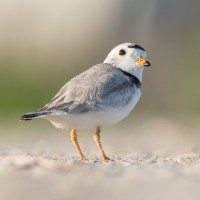 Florida's Winter Warblers & Hidden WondersJanuary 13 - 20, 2026
Florida's Winter Warblers & Hidden WondersJanuary 13 - 20, 2026
-
Essential Information +
Pace & Protocols +
Packing List +
Suggested Reading List +
Useful Links +
Photo credits: Banners: Canopy Tower (courtesy of Canopy Family), Northern Emerald Toucanet, Brown-nosed Three-toed Sloth, Red-capped Manakin (Bryan Calk) Thumbnails: Keel-billed Toucan, Mottled Owl (Bryan Calk), Blue-gray Tanager (Bryan Calk), Boat-billed Heron, Savannah Hawk, Trogon (Bryan Calk), Violet-bellied Hummingbird, Wattled Jacana (Hugh Simmons)





